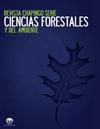吉娃娃西南部的水文气候变率由针叶林年轮推断
IF 0.6
4区 农林科学
Q3 Agricultural and Biological Sciences
Revista Chapingo Serie Ciencias Forestales Y Del Ambiente
Pub Date : 2020-08-30
DOI:10.5154/r.rchscfa.2019.09.071
引用次数: 7
摘要
简介:0807森林管理单位(UMAFOR 0807)是木材和水资源供应方面产量最高的单位之一,但没有对历史水文气候变化及其趋势进行预测性研究。目的:通过奇瓦瓦州西南部的区域树状时间网络生成降水量重建。材料和方法:开发了UMAFOR0807五种不同针叶树的生长系列网络;通过主成分分析,定义了具有最大公方差的序列,以获得具有代表性的年表。重建模型是用一系列区域降水生成的。分析了对降雨量变化影响最大的环流模式以及总环宽指数与干旱指数的关系。结果和讨论:从生成的八个年表中,有六个年表显示了共同的气候反应,以整合一个区域代表性系列,该系列对9月至7月的降水做出了反应。6月至8月期间,总环宽指数与Palmer干旱严重程度指数(PDSI)的相关性为0.68(P<0.01),前一年8月至当年6月的标准化降水蒸发蒸腾指数(SPEI)为0.71(P<0.01)。重建的降水量在2.1年和2.8年的谱峰上表现出显著性,这与ENSO(厄尔尼诺-南方涛动)的影响相对应。结论:由各种树种组成并整合在区域年表中的树状年表网络可以捕捉气候的年际和多年变化。本文章由计算机程序翻译,如有差异,请以英文原文为准。
Chihuahua southwestern hydroclimatic variability inferred with coniferous growth rings
Introduction: The forest management unit 0807 (UMAFOR 0807) is one of the most productive in timber and water
resources provision, but there are no studies of historical hydroclimatic variability and its trends for predictive purposes.
Objective: to generate a precipitation reconstruction through a regional dendrochronological network for the southwest
of the state of Chihuahua.
Materials and methods: a network of growth series of five distinctive conifers of UMAFOR 0807 was developed; through
Principal Component Analysis the series with the greatest common variance were defined to obtain a representative
chronology. The reconstruction model was generated with a series of regional precipitation. The general circulation modes
with the greatest impact on rainfall variability and the association of the total ring-width index with the drought indices
were analyzed.
Results and discussion: From eight chronologies generated, six showed a common climate response to integrate a regional
representative series, which responded to September-July precipitation. The correlation between the total ring-width index
and the Palmer Drought Severity Index (PDSI) was 0.68 (P < 0.01) in the June-August period, and 0.71 (P < 0.01) for the
Standardized Precipitation Evapotranspiration Index (SPEI) for August of the previous year to June of the current year of
growth. The reconstructed precipitation showed significance in spectral peaks of 2.1 and 2.8 years, corresponding to the
influence of ENSO (El Nino–Southern Oscillation).
Conclusions: the dendrochronological network composed of various tree species and integrated in a regional chronology
allowed to capture the interannual and multiannual variability of the climate.
求助全文
通过发布文献求助,成功后即可免费获取论文全文。
去求助
来源期刊
CiteScore
1.20
自引率
16.70%
发文量
0
审稿时长
>12 weeks
期刊介绍:
The Revista Chapingo Serie Ciencias Forestales y del Ambiente (RCHSCFA) is a scientific journal that aims to raise awareness of high-quality research products related to forest, arid, temperate and tropical environments in the world. Since its foundation in 1994, the RCHSCFA has served as a space for scientific dissemination and discussion at a national and international level among academics, researchers, undergraduate and graduate students, forest managers and public/private entities that are interested in the forest environment.
All content published in the journal first goes through a strict triple-blind review process and is published in the following formats: Scientific Articles, Review Articles, Methodologies, Technical or Technological Notes.

 求助内容:
求助内容: 应助结果提醒方式:
应助结果提醒方式:


